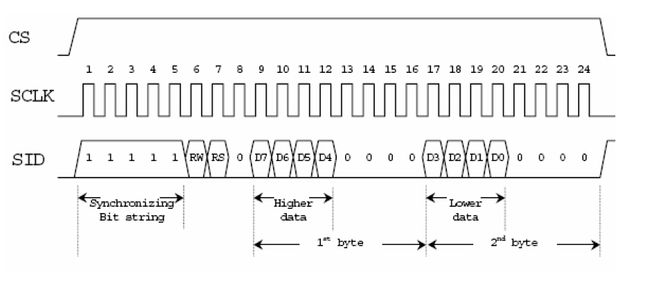以前写12864的液晶程序都是用的并行的方式,这种方式焊接起来很麻烦,而且占用的IO口比较多。
今天尝试使用串行方式来驱动该模块。
本程序是基于STC89C52的12864串行模式的程序,硬件电路连接只需要5根线,VCC GND RS RW E , 只需要三个个IO 口就可以显示,大大节省了资源。
12864液晶芯片是st7920。自带中文字库。
该程序功能:实现使用12864液晶显示字符、汉字(程序有详细的中文注释)。
已经调试通过,很好用。
下面是电路原理图
其时序图如下:
根据其时序图写出其代码如下:
#include
#include
#include
#include
#defineucharunsignedchar
#defineuintunsignedint
sbit CS=P2^7;//第4根线 RS
sbit SID=P2^6;//第5根线 RW
sbit SCK=P2^5;//第6根线 E
uchar code AC_TABLE[]={
0x80,0x81,0x82,0x83,0x84,0x85,0x86,0x87,//第一行汉字位置
0x90,0x91,0x92,0x93,0x94,0x95,0x96,0x97,//第二行汉字位置
0x88,0x89,0x8a,0x8b,0x8c,0x8d,0x8e,0x8f,//第三行汉字位置
0x98,0x99,0x9a,0x9b,0x9c,0x9d,0x9e,0x9f,//第四行汉字位置
};
/******************************** 函数名称 :SendByte 串口发送一个字节*****/
voidSendByte(ucharDbyte)
{
uchar i;
for(i=0;i<8;i++)
{
SCK=0;
Dbyte=Dbyte<<1;
SID=CY;
SCK=1;
SCK=0;
}
}
/***********接收一个字节***/
ucharReceiveByte(void)
{
uchar i,temp1,temp2;
temp1=0;
temp2=0;
for(i=0;i<8;i++)
{
temp1=temp1<<1;
SCK=0;
SCK=1;
SCK=0;
if(SID)temp1++;
}
for(i=0;i<8;i++)
{
temp2=temp2<<1;
SCK=0;
SCK=1;
SCK=0;
if(SID)temp2++;
}
return((0xf0&temp1)+(0x0f&temp2));
}
voidCheckBusy(void)
{
doSendByte(0xfc);
while(0x80&ReceiveByte());
}
voidWriteCommand(ucharCbyte)
{
CS=1;
CheckBusy();
SendByte(0xf8);
SendByte(0xf0&Cbyte);
SendByte(0xf0&Cbyte<<4);
CS=0;
}
voidWriteData(ucharDbyte)
{
CS=1;
CheckBusy();
SendByte(0xfa);
SendByte(0xf0&Dbyte);
SendByte(0xf0&Dbyte<<4);
CS=0;
}
ucharReadData(void)
{
CheckBusy();
SendByte(0xfe);
returnReceiveByte();
}
voidDelay(uintMS)
{
uchar us,usn;
while(MS!=0)
{
usn=2;
while(usn!=0)
{
us=0xf5;
while(us!=0)
{
us--;
};
usn--;
}
MS--;
}
}
voidLcmInit(void)
{
WriteCommand(0x30);
WriteCommand(0x03);
WriteCommand(0x0C);
WriteCommand(0x01);
WriteCommand(0x06);
}
voidLcmClearTXT(void)
{
uchar i;
WriteCommand(0x30);
WriteCommand(0x80);
for(i=0;i<64;i++)
WriteData(0x20);
}
voidPutStr(uchar row,uchar col,uchar*puts)
{
WriteCommand(0x30);
WriteCommand(AC_TABLE[8*row+col]);
while(*puts!='\0')
{
if(col==8)
{
col='0';
row++;
}
if(row==4)row='0';
WriteCommand(AC_TABLE[8*row+col]);
WriteData(*puts);
puts++;
WriteData(*puts);
puts++;
col++;
}
}
voidDisplayDots(ucharDotByte)
{
uchar i,j;
WriteCommand(0x34);
WriteCommand(0x36);
for(i=0;i<32;i++)
{
WriteCommand(0x80|i);
WriteCommand(0x80);
for(j=0;j<32;j++)
{
WriteData(DotByte);
}
DotByte=~DotByte;
}
}
voidmain(void)
{
Delay(100);
LcmInit();
LcmClearTXT();
while(1)
{
PutStr(0,0,"欢迎光临");
PutStr(1,0,"Rayu技术分享");
PutStr(2,0,"http://blog.rayu");
PutStr(3,0,"u.com/");
}
}
显示效果如下:


